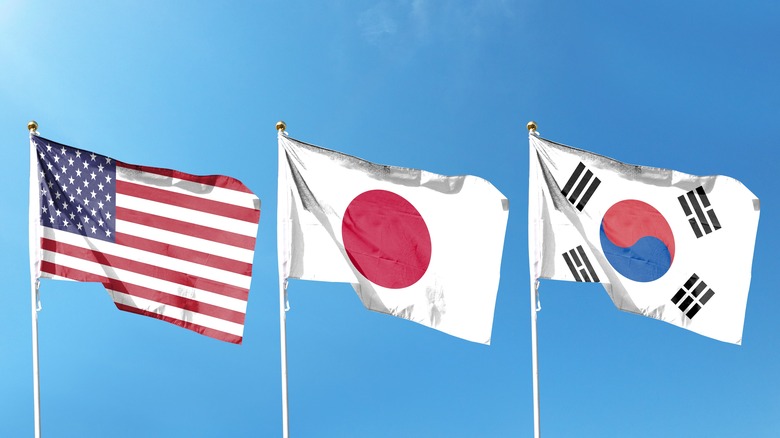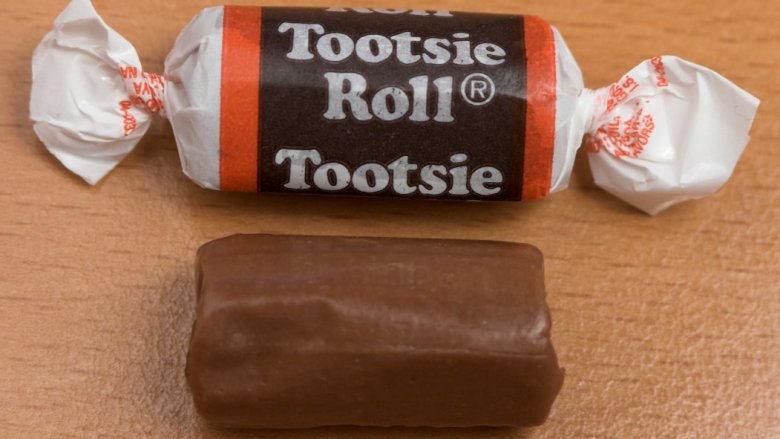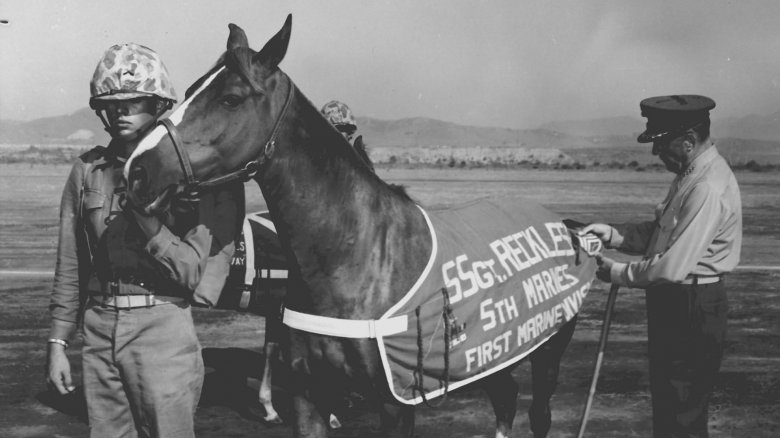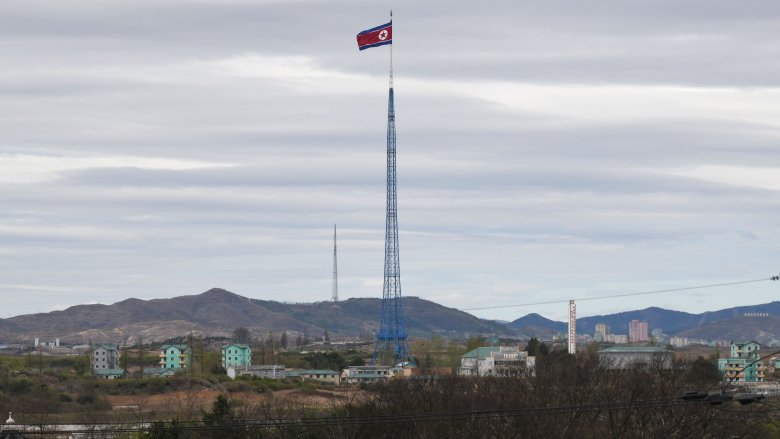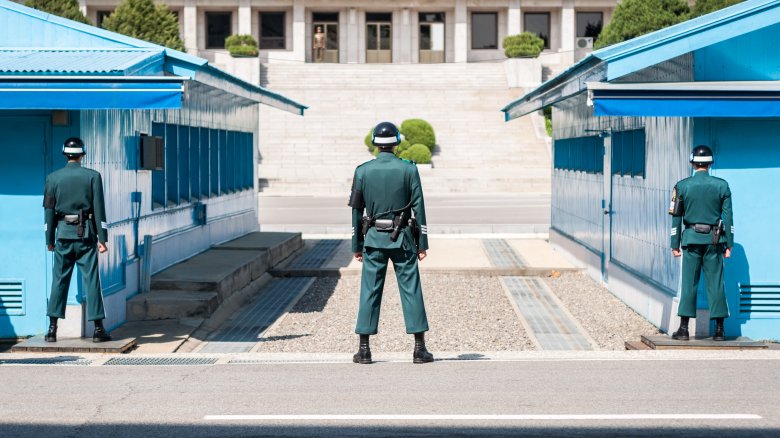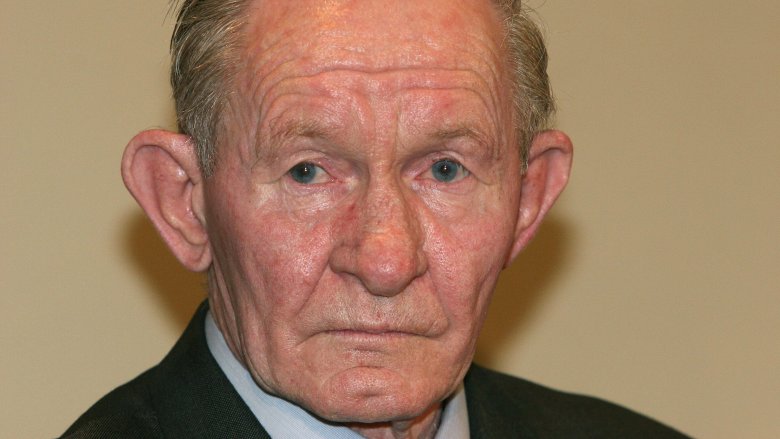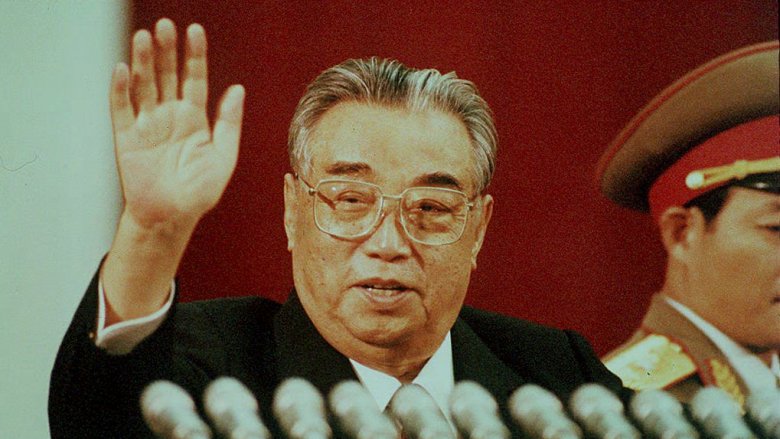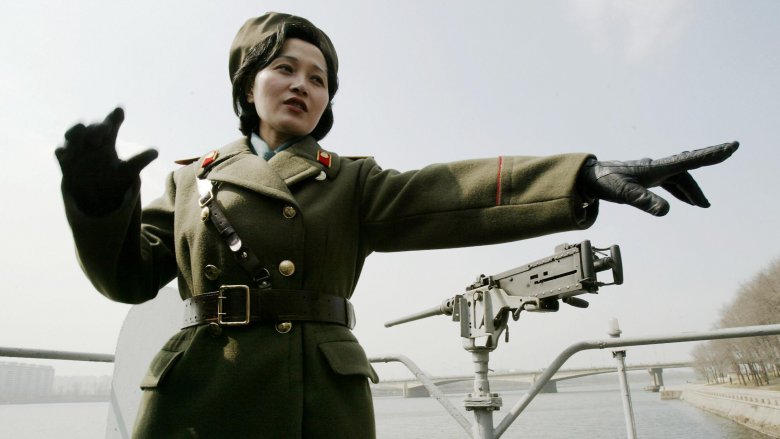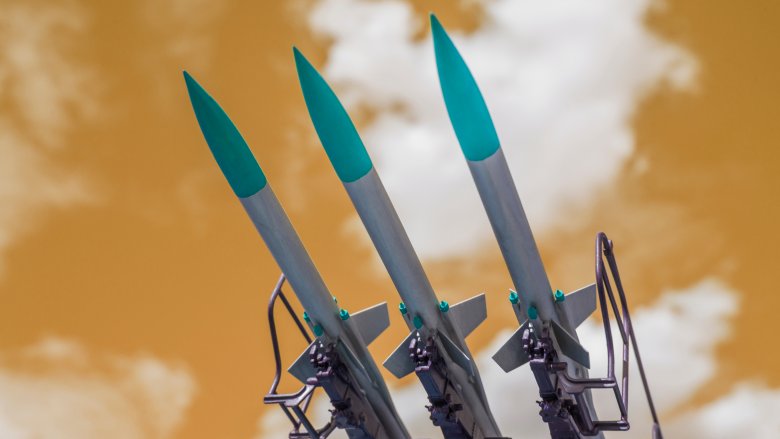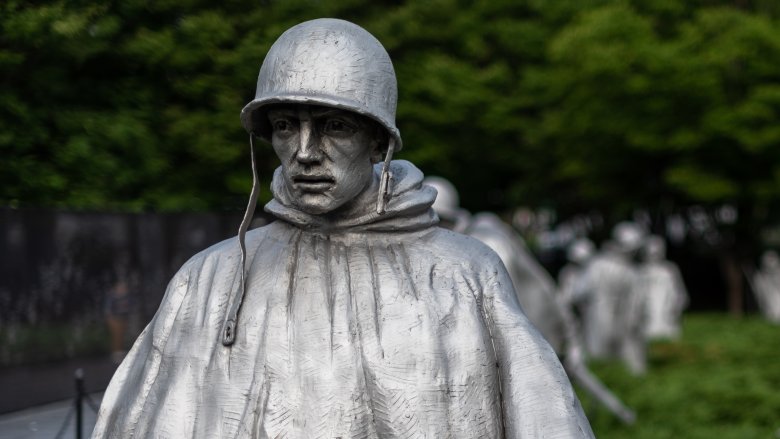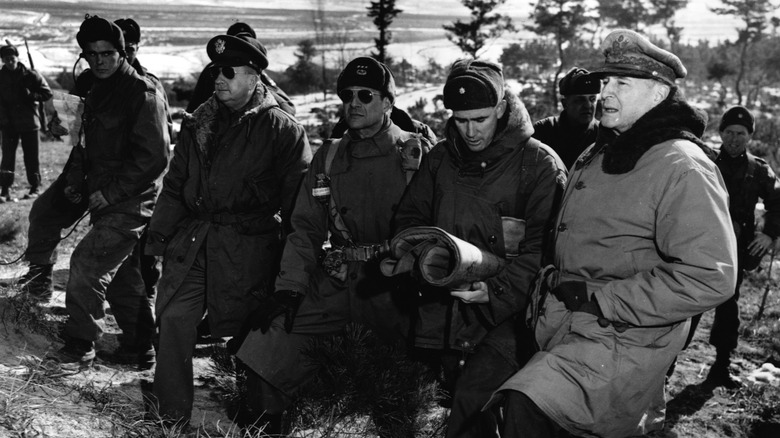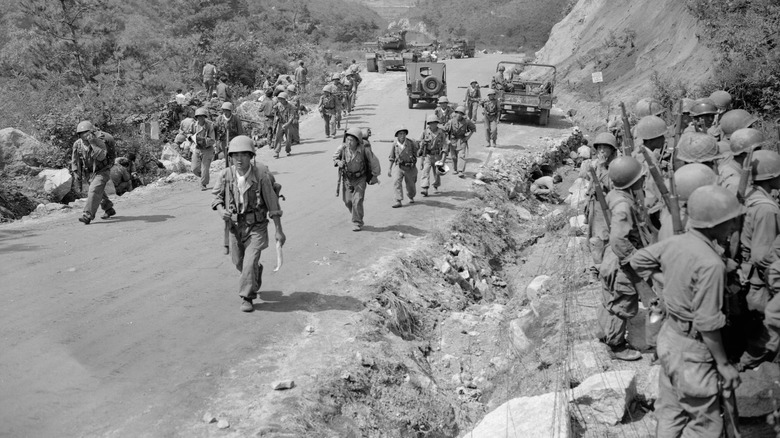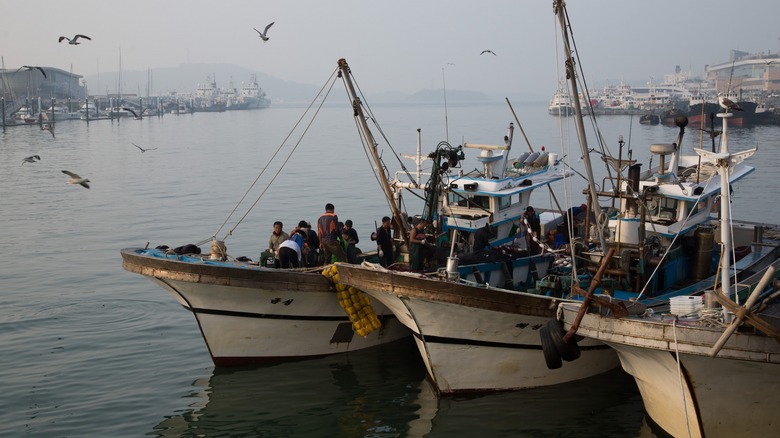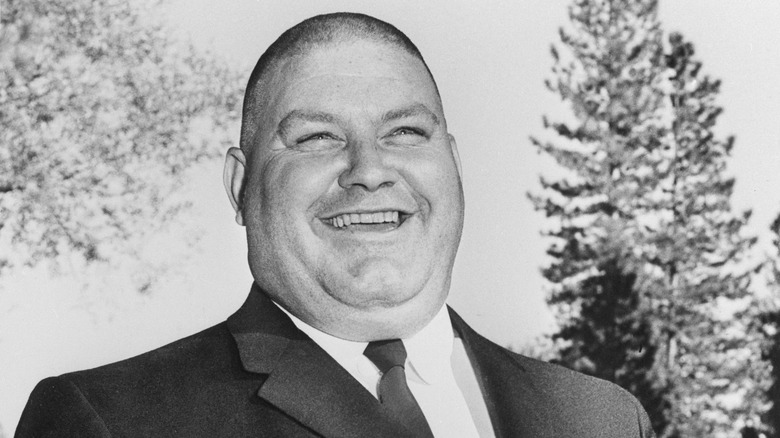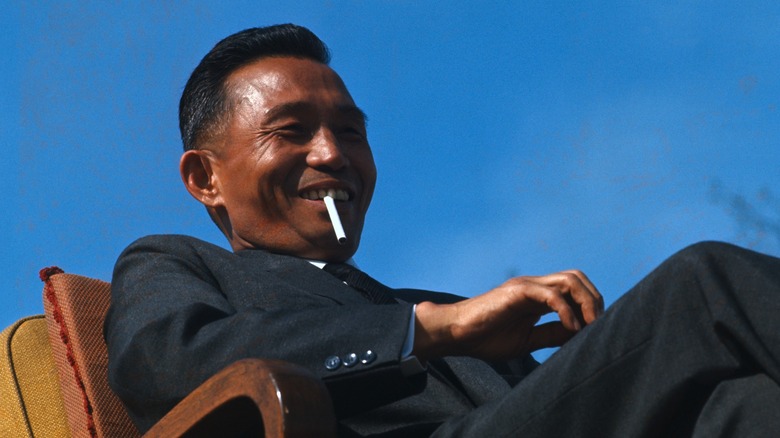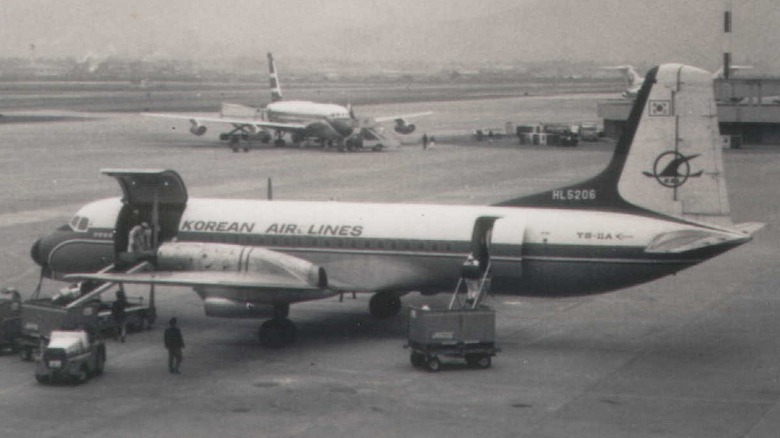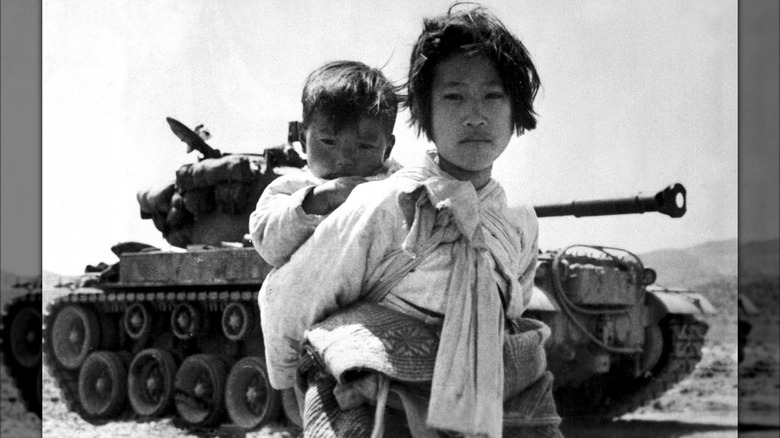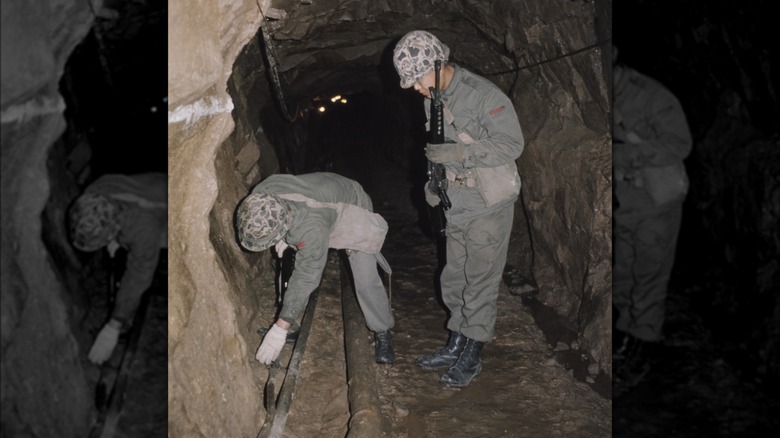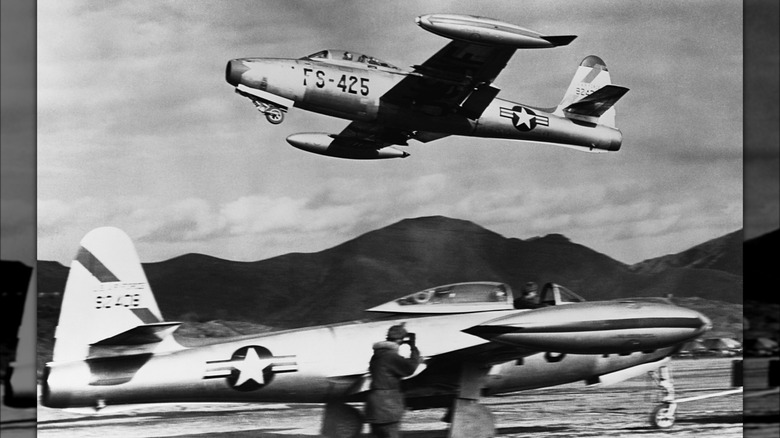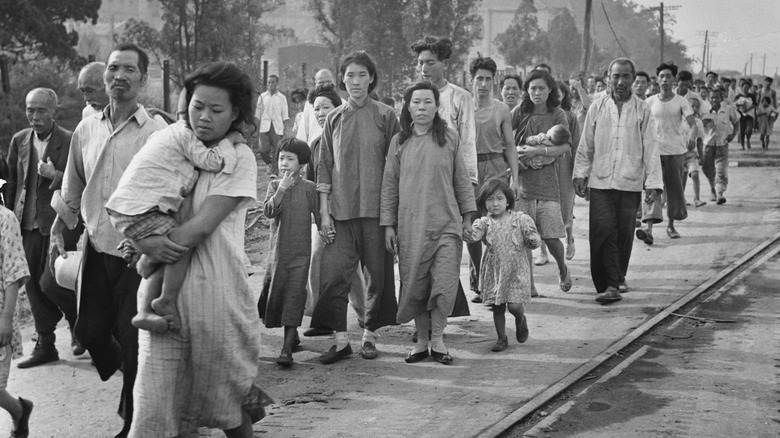The Most Bizarre Things About The Korean Conflict
The Korean War is the middle child of military conflicts. Sandwiched between World War II and the Vietnam War, it's often remembered for being forgotten. It started on June 25, 1950, when North Korean forces led by Communist dictator Kim Il-sung invaded South Korea. The United States led an international effort to repel the Communists, and China provided reinforcements for North Korea. It was a war of historical firsts. Never before had the U.S. and China engaged each other in an actual war. It was also first time the U.S. Congress didn't formally declare war and the first conflict to include racially integrated U.S. units. A 1953 armistice stopped the fighting, but there was no peace treaty, which means the Korean conflict still hasn't ended technically.
The conflict permanently altered North Korea, which became an isolated, dystopian twilight zone governed by batty dictators. Current autocrat Kim Jong-un is so paranoid that he travels with a portable toilet so no one can analyze his poop. His father/predecessor, Kim Jong-il, claimed he didn't poop at all and bragged about impossible accomplishments. Yet their jarring oddness pales in comparison to the outlandish details of the conflict that shaped the Hermit Kingdom.
The psychotic spymaster who decided the war's outcome
Of all the major players in the forgotten war, Donald Nichols might be the one America tried hardest to forget. A seventh-grade dropout from an impoverished background, Nichols only joined the military because civilian life was so rough, per the Seattle Times. His knack for languages and complete lack of conscience helped him gain favor with South Korean strongman Syngman Rhee. Nichols attended torture sessions by South Korean police, according to historians, and even posed for a photo with a detached human head. Cold and calculating, he would make himself indispensable to U.S. and South Korean forces during the war.
Thanks to a North Korean defector with stolen military codebooks, Nichols had the means to decipher enemy communications and foil their operations. Rather than sharing that crucial info with intelligence agencies, he formed his own group of codebreakers, forcing the U.S. and South Korea to rely on him. He helped determine which targets to bomb and warned about planned North Korean attacks. Because of how important he was, Nichols literally got away with murder. When subordinates disagreed with him he shoved them out of airplanes and off of boats. He even had a shoot-out with his own agents. After the war the U.S. military got sick of Nichols and had him placed in a straitjacket and subjected to months of electroshock therapy.
When Tootsie Rolls saved the day
At first glance, Tootsie Rolls could easily be confused with gnome droppings. But if you need to patch up bullet holes in subzero temperatures, they're a godsend. Thanks to a ridiculous but fortuitous mix-up, Marines discovered that wacky fact amid the bitterest battle of the Korean War. As History detailed, in the early months of the war, North Korean forces were so overwhelmed that General Douglas MacArthur predicted the whole thing would be wrapped up by Christmas. Then Chinese troops unexpectedly entered the fray at North Korea's Chosin Reservoir, a region loathingly dubbed "frozen Chosin" by the Marines.
Instead of crushing North Korean Communists, the Marines found themselves cornered by 100,000 Chinese combatants in a mountainous region where temperatures reached as low as -25 degrees. So they embarked on a 70-mile retreat, or as the commanding officer called it, "advancing in another direction." Bullet wounds froze in the perilous cold, and ice-cold corpses were used as sandbags. As ammunition dwindled, the troops requested an airdrop of 60mm mortar ammo, which Marines referred to by the codename "Tootsie Rolls." However, the radio operator mistakenly called in an urgent order for chocolate candy. The Marines figured out they could melt Tootsie Rolls in their mouths and form a kind of putty that would seal bullet-hole-ridden equipment as it froze. That MacGyver-like ingenuity allowed them to accomplish their mission and take out several Chinese divisions.
GIs said they fought a UFO before mysteriously falling ill
Before we dig into this, it's important to keep in mind that while UFOs are commonly assumed to be extraterrestrial spacecraft, the term "UFO" literally just refers to any flying object that an eyewitness didn't recognize. If you have no clue what a helicopter is and one flies by you, for you it counts as a UFO. But what counted as a UFO for GIs during the Korean War?
As History recounted, in 1951, troops stationed roughly 60 miles north of Seoul saw what resembled "a jack-o-lantern come wafting down across the mountain." Eyewitnesses claimed the craft could hover and emitted an orange and later blue-green flashing light. It seemed immune to explosions, and attempts to down it with armor-piercing bullets caused the craft to move unpredictably. Before racing away, it unleashed waves of light that allegedly caused a "burning, tingling sensation." Three days later, everyone in the unit was too sick to walk.
The men were diagnosed with everyone's favorite wartime illness: dysentery. However, an ex-NASA scientist thought their symptoms were consistent with radiation poisoning. Whatever the case, the soldiers blamed the explosion-proof jack-o-lantern. Were the men the victims of a Soviet death ray as some suggested, or worse, a Soviet diarrhea ray? Perhaps stress made the troops hallucinate. If so, at least 42 witnesses had an eerily similar delusion. Or you can blame aliens. You know you want to.
A beer-drinking horse became a sergeant
It's not every day that a horse holds rank in a human hierarchy. (The Roman emperor Caligula allegedly made his horse a high-ranking government official, but that story might have been fabricated to make Caligula seem crazy.) However, America absolutely had an equine sergeant and her story is really crazy.
A packhorse for the Marine Corps, Sergeant Reckless (above) was named after the dangerous-to-handle recoilless rifles, dubbed "reckless" rifles, whose ammunition she carried. She is best known for her invaluable efforts during the 1953 Battle for Outpost Vegas, where fighting was so ferocious that one serviceman said it sounded like "twenty tornadoes tearing at a countryside," as per "Reckless: Pride of the Marines." Reckless made 51 round trips across mountainous terrain and rice paddies to transport ammo. She also wore flak jackets and shielded Marines. In total, Reckless traveled over 35 miles and toted 8,800 pounds of ammunition.
Reckless wasn't just a workhorse; she was a cherished friend. She slept in the Marines' tents and had meals alongside them. Not your typical oat-muncher, she ate eggs, bacon, candy bars, blankets, and even poker chips. She was also known to drink beer, coffee, and Coca-Cola. Reckless was so popular and appreciated that when the military wanted to leave her behind, a Marine paid $1,200 of his own money to bring her to the U.S. In 1954, Reckless was promoted to the rank of staff sergeant twice.
The Korean flag war
George Carlin famously compared war to "a whole lot of men standing out in a field" and waving their pocket rockets at each other (metaphorically, of course) to compensate for insecurity about the size of their weapons. That would certainly explain why ceasefire talks during the Korean War got derailed by a fight over (literal) flagpole size.
Ceasefire negotiations started in 1951, and as the Atlantic reported, North Korea desperately wanted to look strong. During one session, North Korea's lead negotiator spent two hours and 11 minutes staring at a U.S. vice admiral and silently chain-smoking. The legs of the admiral's chair were also shortened to make the negotiator appear taller. North Korean General Lee Sang Cho let flies crawl over his face as a show of "iron self-control." But all absurdity broke loose when the North Koreans noticed that the UN flag on the conference table was bigger than theirs.
Evidently feeling emasculated, North Korea brought out a bigger flag. Then South Korea whipped out an even bigger flag, triggering history's most Freudian conflict. According to the Independent, North and South Korea kept one-upping each other until neither nation's flags fit inside the conference room. The countries continued their flagpole fight in the demilitarized zone. Eventually, South Korea erected a 323-foot pole, and the North responded with 525-foot pole, which for a time was the tallest on Earth.
A tree almost sparked a second Korean War
Following the 1953 ceasefire, America and North Korea maintained a mostly bloodless animosity toward each other. However, in 1976, they verged on all-out war after a disagreement over a tree. Located in the demilitarized zone, the 40-foot poplar blocked a United Nations Command observation post from viewing the so-called "loneliest checkpoint in the world," according to the Atlantic. So U.S. Army Captain Art Bonifas and First Lieutenant Mark Barrett attempted to trim the tree.
North Korea balked at the idea, and the infamously belligerent Lieutenant Pak Chul warned Captain Bonifas: "The branches that are cut will be of no use, just as you will be after you die." Bonifas continued trimming, so Pak commanded 30 North Koreans to kill him. Using crowbars, pipes, and axes snatched from nearby South Korean laborers, the assailants beat Bonifas and Barrett to death. The U.S. was incensed, and Secretary of State Henry Kissinger suggested attacking a North Korean barracks. President Ford opted for a ginormous show of force dubbed Operation Paul Bunyan.
American aircraft carriers entered Korean waters, and conventional and nuclear munitions were moved to bunkers. North Korea responded by assuming "full combat readiness" and conducting air-raid exercises. The ordeal ended with hundreds of heavily armed U.S. and South Korean troops, backed by helicopters and nuclear-capable aircraft, amassing in the DMZ to oversee the tree trimming while heavily armed North Koreans watched.
The missing sergeant forced to star in North Korean movies
During the 1960s, the DMZ (demilitarized zone) was sorely lacking in D. As the BBC described, the not-so-demilitarized zone was strewn with landmines, and battles between North and South Korean forces were commonplace. U.S. Army Sergeant Charles Jenkins (above) was assigned to help keep the nonexistent peace, but his mind was occupied by war, namely the Vietnam War, which he feared was his next destination. By 1965 the DMZ was at its most acrimonious, and Jenkins couldn't cope with his circumstances. He later recalled feeling like he would "cause other soldiers to be killed" (via the BBC). In a panic he crossed into North Korea, which he hoped would send him to the Soviet Union to seek amnesty.
North Korea kept Jenkins all to itself. Held against his will, he was habitually tortured and forced to undergo self-criticism sessions. Also viewed as a useful propaganda tool, he was forced to star in North Korean movies. Eventually he married a Japanese nurse who had been kidnapped by the North Korean government. In 2002, Japan arranged for her release, and two years later Jenkins was allowed to leave. After turning himself in to U.S. military police, he was tried for desertion and sentenced to 30 days in prison.
North Korea kidnapped more than 80,000 South Koreans
Kim Il-sung (above) was the granddaddy of North Korean insanity in that he was the country's first dictator, he was Kim Jong-un's grandfather, and he was insane. During the Korean War, he orchestrated the abduction of an estimated 84,000 South Koreans. To be clear, these weren't prisoners of war or deemed enemies in any way. Rather, as the New Yorker explained, Kim Il-sung longed to "compensate for the mass exodus" that occurred when Japan occupied the Korean peninsula and tried to assimilate Korean people into Japanese culture. After World War II, Japan was ousted, North and South Korea were formed, and the newly formed rivals competed to see which could establish itself as the "legitimate homeland" of the Korean people.
After the 1953 armistice, North Korea continued its forced repopulation project, primarily abducting South Korean fisherman. This went on for decades, and Reuters reported that South Korea scarcely acknowledged the kidnappings for fear of angering its ornery northern neighbor. Over time, other foreign nationals were targeted. Between 1977 and 1983, North Korea kidnapped somewhere between 20 and 100 Japanese citizens, often hauling them away from their homeland in sacks.
Prisoners were forced to train North Koreans to pass as foreigners for espionage operations or conduct spy missions themselves. U.S. Sergeant Charles Jenkins, who was trapped in North Korea for 39 years after attempting to seek asylum, claimed North Korea had a spy-breeding program that involved having prisoners produce interracial children with Koreans.
America's awkward apology to North Korea
Many people, politicians especially, despise apologizing. Admitting fault makes people feel weak and embarrassed, per Scientific American, and apologizing to someone is often seen as yielding control. However, in 1968, America had to swallow its pride and (sort of) apologize to North Korea.
Per NPR, North Korean ships attacked the USS Pueblo, a spy vessel pretending to conduct environmental research near North Korea. One crewman was killed, and the remaining 82 Americans were imprisoned and tortured for 11 months. To save his crew from execution, Lieutenant Commander Pete Bucher confessed to espionage. In a hilarious act of defiance, Bucher purposely mispronounced the word "paean" as "pee on" while reading his confession. So instead of expressing a "fervent desire" to praise (paean) North Korean officials, he said he wanted to urinate on them.
In addition to Bucher's declaration, North Korea demanded an apology from the U.S. government. It was a diplomatic pickle for President Johnson, who had tried and failed to intimidate North Korea into releasing the crewmen. Furious Americans called Johnson a coward for not using military force, but the Vietnam War was intensifying, and it was better to have wounded pride than more wounded soldiers. So an American negotiator signed an apology letter while verbally denying its validity. Nonetheless, "it was a hell of an embarrassment," and North Korea kept the captured ship as a trophy.
The U.S. kept threatening to nuke North Korea
North Korea is a pathological saber-rattler. Its track record of aggressive gestures includes firing missiles near and over Japan, sending troops to the DMZ, and threatening to bomb the bejesus out of America. The scary part is that North Korea possesses an estimated 20 to 60 nuclear weapons. The U.S. has tried to curb the country's nuclear ambitions through sanctions and condemnations, but it might be tough to persuade the Hermit Kingdom after the U.S. destroyed North Korea and threatened it with nukes for decades.
Most of the Korean War was fought under President Truman, who atomically bombed Japan during World War II. In 1950, he considered doing the same to North Korea, and according to Air and Space Magazine, he almost did. To show he meant business, Truman held a press conference to announce that he'd do anything to win, including nuking the enemy. He even ordered mock atomic bombing runs and authorized a general to use the nuclear option if he saw fit.
America didn't need nukes because it "dropped 635,000 tons of explosives on North Korea," according to Newsweek, including 32,557 tons of napalm." Per the Bulletin of Atomic Scientists, beginning in 1958, the U.S. "continuously" deployed nuclear weapons in South Korea for 33 years to deter the North. Fearing a U.S. invasion, North Korean leader Kim Il-sung began trying to build nukes in the 1980s.
The official U.S. death toll was way too high for decades
The Korean War had an enormous death toll. As many as 5 million people perished, and the Koreas lost about 10 percent of their civilian populations, according to History. Until 2000, the official U.S. death toll was listed as 54,246, a number literally etched in granite on the Korean War Veterans Memorial. That figure was entirely too high. We don't mean that morally or philosophically. We're talking about the gap between the stated number and what the evidence indicates. By that metric, the actual death toll was 36,516. In other words, the official tally was almost 50 percent too high for a half century.
How was it so wrong for so long? In a baffling clerical error that apparently went unnoticed, the death toll included fatalities from around the world, often from places as far away as Germany and the U.S., per The Washington Post. Despite the disparate locations, excluding the deaths proved controversial. Some Korean War veterans took felt it devalued the already overlooked sacrifices of those who fought in the Forgotten War.
An imaginary king might be the key to reunification
North Korea is the geopolitical equivalent of a fever dream. Where else will you find a head of state who tries to build credibility by announcing the discovery of a unicorn lair or who claims that when the previous leader died, the sky glowed and a snowstorm stopped? The place would be political Narnia if it weren't so brutally oppressive. Perhaps fittingly, a fantastical tale about a king who likely never existed could play a key role in formally ending the Korean War and reuniting the divided Koreas.
Korean legend has it that the peninsula's first kingdom was founded by a dude named Dangun, whose father was the king of heaven and whose mother was a bear that transformed into a "beautiful woman" after spending 100 days in a cave avoiding sunlight. South Korean professor Jeong Young-Hun explained to Reuters that "Dangun is a basis for Koreans to feel the necessity for pursuing harmony and unification" because he establishes a sense of shared origins and cultural oneness. That elusive reunion seemed a little more attainable in 2018 when North and South Korea's leaders met and visited the mythical birthplace of Dangun together.
Seoul City Sue
During the war, many U.S. troops reported hearing broadcasts over the radio from an unidentified woman, who sounded American but spread North Korean propaganda. They named her Seoul City Sue, a callback to Axis Sally, the Nazi propagandist from World War II. Little is known about Sue, but she has since been identified as Anna Wallis Suh, an American missionary who moved to Korea in the 1930s.
Accounts differ, but most think Suh and her husband were living in South Korea after World War II, but the U.S. suspected her husband was a communist and briefly imprisoned him. When the communists took over Seoul in June 1950, Suh and her husband stayed behind and apparently pledged their loyalty to the North Korean state. Suh then allegedly started to give the anti-American propaganda blasts. She especially implored the Black troops to give up and stop fighting, often bringing up racist incidents in Korea and back stateside.
Even today, historians don't know why Suh was broadcasting. Her friends and family think the North Koreans forced her to do it under threat of death, though others think she was actually a radicalized communist believer. After the Americans retook Seoul, almost nothing is known about Suh's fate. Some American prisoners later reported that a woman with her name gave indoctrination sessions to them in captivity. Another wrote that she was a double agent whom the North executed in the 1960s.
A former U.S. code clerk helped spark the war
If it hadn't been for a pair of traitorous United States code clerks working at the U.S. embassy in Moscow, the Korean War may never have started. By 1948, the Cold War between the U.S. and Soviet Union was well underway, and both sides were looking for any advantage they could get over the other. For the KGB, the Russian version of the CIA, this meant trying to recruit American code clerks who worked at the U.S. embassy located in Moscow (according to Tennent H. Bagley's "Spymaster").
At some point, KGB officers successfully flipped Sgt. James McMillin after discovering his relationship with a Russian woman named "Valya," but he was only able to give them limited information. However, the KGB soon discovered another potential recruit, codenamed "Jack," who they also flipped due to his relationship with a Russian woman, "Nadya." The KGB started paying Jack handsomely for information as well as broken cipher parts, and soon they were able to crack American codes.
After cracking the American ciphers and believing they would not stand in the way, Joseph Stalin finally acquiesced to North Korean leader Kim Il-Sung's request to invade the South, and the war kicked off in June 1950. The Soviets had access to American communications for months after Jack's treason, and without the two clerks, especially Jack, Stalin may never have allowed the invasion, and the fighting may have never broken out at all.
Every continent except Antarctica has sent troops
It's a bit jarring when you first realize it, but with the exception of Antarctica, every single continent has sent troops to fight in the Korean War. Most of them fought as part of the United Nations contingent that also included American troops, and there are some incredibly varied stories. One of the more surprising countries to have sent troops was Colombia, who were the only Latin American troops in the entire war. More than 5,000 Colombians fought for the U.N., with 200 either getting killed or ending up missing in action. The country continues to support the U.N.'s mission in Korea.
From the continent of Africa, both South Africa and Ethiopia fought with the U.N, coalition. Roughly 3,500 Ethiopians served in the Korean War, even earning a citation for their heroics in repelling a Chinese attack, and suffered 121 casualties. South Africa sent 826 officers during the fighting, with 37 of them getting killed.
Turkey joined the coalition very early in the war, just months after it broke out, and they sent more than 30,000 troops to fight over the course of the war until the armistice. In many ways, the Korean War is essentially another world war, just with the combat all taking place in one area.
The North kidnaps Japanese fishermen
It doesn't make a ton of sense for a conflict taking place between North and South Korea, but unfortunately, many Japanese fishermen have found themselves ensnared by the gigantic reach of the war. According to The Committee on Human Rights in North Korea, in addition to abducting more than 3,700 South Korean fishermen since 1953, the North has also taken many Japanese hostages, too.
One particularly strange and harrowing incident happened back in May 1963, though authorities would not learn the true circumstances until the late 1990s. On May 11, three Japanese fishermen were working near the Ishikawa Prefecture in Japan when they somehow ran into a North Korean spy ship trying to do espionage. Not wanting to risk blowing their cover, the North Koreans ordered the Japanese onto their boat, but not before killing one of them, 36-year-old Shoji Terakoshi. The spies then took the other two, 13-year-old Takeshi Terakoshi and 24-year-old Soto-o Terakoshi, to North Korea, likely against their will.
While it's thought Soto-o died in North Korea in 2002, four years after the South learned about the story, Takeshi was allowed to return to Japan briefly. However, instead of fleeing the North and telling wild tales about forced imprisonment and torture, Takeshi actually claimed to like the North. It's unknown if Takeshi was under some kind of duress when he made the claim, but the fact that he voluntarily returned to North Korea after his visit adds another layer to the already confounding story.
Doctor Joseph Cyr, or Ferdinand Demara Jr.?
Of all the unbelievable stories from the Korean War, the saga of Ferdinand Demara Jr. is by far one of the most outlandish. Born in America, Demara managed to con his way into the U.S. Navy in 1941 at age 19 using a stolen name. There, he went through basic medical training, but he ended up faking his death and fleeing when the ruse was discovered. He later served time in prison for desertion after being caught stealing a dead teacher's identity. In 1950 in Maine, he met a Canadian doctor named Joseph Cyr just as fighting broke out in Korea.
After making fake copies of Cyr's documents, Demara headed north and joined the Canadian Navy, using Cyr's name to enlist. Somehow, Demara made it through the process as Cyr without anyone realizing it, and in 1951 he started serving on the HMCS Cayuga destroyer. During his time as the fake Cyr, Demara did dental work, amputated a man's leg, and removed a bullet, among other minor tasks — and nobody seemed to know he was not a real doctor.
It was not until the media publicized his actions that news made its way to the real Cyr, who promptly pulled the plug. The navy did not prosecute Demara for his actions, and he even earned the respect of his patients, who considered him a hero. Later the film "The Great Imposter" was made based on his life.
The Blue House Raid
Known as the Blue House Raid, North Korea's attempted assassination of South Korean President Park Chung-hee (pictured above) is almost too astonishing to take seriously. The incident began in January 1968, when 31 North Korean commandos from the secretive Unit 124 breached the South Korean border from the North. Their goal: behead Chung-hee at his residence, the Blue House, in Seoul.
Almost immediately, the commandos encountered South Korean civilians who were woodcutters going out to work. The woodcutters thought they were friendly South Korean soldiers, but as soon as they got close they realized their mistake. Yet, instead of killing the civilians, the North Koreans tried to lecture them on the finer points of communism and convert them — but they completely failed. Though the woodcutters signed a contract promising to be loyal, they immediately told the South Korean army. A few days later, the North Koreans had made their way to within 350 yards of the Blue House, where they engaged in a shootout with South Korean troops protecting the president.
In the end, 29 of the 31 North Koreans died. Of the two survivors, one of them escaped to the North and another surrendered to South Korean forces. The one who surrendered, Lt. Kim Shin-jo, cooperated with his captors, eventually earning the right to live out his life as a free man in the South, though the North executed all seven members of his family living there in retaliation.
The hijacking of Korean Airlines flight YS-11
On December 11, 1969, Korean Airlines flight YS-11 took off in South Korea for what was supposed to be a domestic flight. However, North Korean hijacker Cho Chang-hee quickly took control of the plane, and he made the pilots divert their plans and instead head directly north across the border. There were 51 souls onboard the flight including Chang-hee, and he was the only North Korean citizen. There is no indication about what the hijacker's precise motive was, other than harassing the South, and it happened more than a decade-and-a-half after the combat-phase of the Korean conflict had passed, though almost two years after the infamous Blue House raid.
The North Koreans kept all 50 of the South Koreans hostage for just over two months, until they allowed 39 of them to leave on February 4, 1970. That kept 11 abductees still in North Korean custody, which the North claimed was because they wanted to stay, but the other passengers say that was a lie and they wanted to return home, too.
Ever since, the international community has pleaded with North Korea to release the hostages, but to no avail. It's unclear what the North is attempting to gain by not releasing them, and the entire incident makes little sense diplomatically or politically. All 11 are still thought to be imprisoned in the North, and there is little hope for their repatriation — if they are even still alive.
[Image by Japangyro via Wikimedia Commons | Cropped and scaled | CC BY-SA 3.0]
The 1974 Suwon-ho incident
Of the over 3,800 South Koreans the North Koreans forcibly kidnapped between 1953-2011, after the combat phase of the conflict ended, 3,721 of them were fishermen (via The Committee on Human Rights in North Korea). These disproportionate statistics are due to a number of altercations between South Korean fishermen and North Korean commandos, which often ends with the South Koreans in custody.
One particularly bewildering incident took place on February 15, 1974, involving two South Korean fishing boats, the Suwon-ho 32 and the Suwon-ho 33 (via transcripts of the 348th Meeting of the Military Armistice Commission). While fishing in international waters, according to the U.N. command, a North Korean gunboat opened fire and sank the Suwon-ho 32, killing 13 of the 14 crew onboard and imprisoning the survivor. However, the North Koreans claim that the fishing vessel was actually conducting secret espionage on behalf of South Korea in North Korean territorial waters, and the shooting was in self-defense.
Yet, what truly makes the story unusual is that after the North Koreans sank the Suwon-ho 32, they towed the other boat to the North before apparently releasing it. However, they immediately changed their minds and detained the ship indefinitely, forcing the 14 crewmembers to falsely confess to being CIA agents. Since the incident, only one crew member was ever seen again, when he saw his family for a few moments in February 2014, but the fate of the other 14 crew is unknown.
The North Korean tunnels are now tourist attractions
Since the signing of the 1953 armistice that formally ended the combat-phase of the Korean conflict, North Korea has tried to infiltrate South Korea in a number of ways. Of them all, their most bizarre attempts have to be the various underground tunnels that the South Korean army first discovered in the mid-1970s. It's unknown exactly why the North built the tunnels or if they were actually planning some kind of invasion, but the South Koreans found four different tunnels, in 1974, 1975, 1978, and 1990.
One of them was large enough to shuttle through at least 30,000 troops in only an hour, while the others were much smaller. It's somewhat due to the ineptitude of the North Koreans building the tunnel that the South Koreans even discovered them at all. They found the first one after seeing steam mysteriously coming up from the ground, and the 1978 tunnel discovery happened after an old dynamite charge went off and alerted authorities.
Adding even another layer to the already strange story, today one of the tunnels is actually open, but instead of North Korean troops walking through, it's mainly South Korean tourists. The South Korean government charges $10 USD to enter the tunnels hundreds of feet below ground, and they are seemingly quite popular. It's a bit strange to consider, but it seems that North Korea inadvertently subsidized building a tourist attraction for the South, something they can't be too happy about.
It was the only time Americans fought Soviets in the Cold War
Of all the places that the U.S. and Soviet Union could have engaged in combat during the Cold War, one of the unlikeliest was surely the Korean War. While the American contribution to the air war above Korea has long been heralded, the Soviet's role was only widely reported on in the 1990s, four decades after the original fighting ended (via VFW Magazine).
Incredibly, Soviet pilots actually flew the majority of air combat missions launched during the war by the North, but even the Russian public had absolutely no idea. In order to stop the Cold War from becoming a hot one, both governments publicly denied that any air combat between them was taking place, even after an American reporter wrote about it. The Soviets covered up the deaths of the hundreds of pilots that are thought to have perished (the exact number not entirely known), and they gave their families excuses like they died from disease, and they buried the bodies in Port Arthur, China.
The fighting was incredibly fierce and was triggered by a botched attack in October 1950, when U.S. pilots accidentally fired into Soviet territory thinking they were still in North Korea, leading to Soviet retaliation. Soviet MiG-15s mainly fought American F-86, F-84 (pictured above), and F-80 jets, along with B-29 bombers, and the dog fights are the only known instances of U.S. and Soviet combat during the Cold War.
The South sued the North about they blew up a building
On Tuesday, June 16, 2020, North Korea made headlines by blowing up an office building in their own territory. In 2018, a liaison office that connects the Northern and Southern governments constructed the building just north of the demilitarized zone, and at the time it was a sign of good faith. Negotiations between North Korean leader Kim Jong-un and U.S. President Donald Trump had been heating up, partly because of the diplomacy of South Korean President Moon Jae-in, who the office was dedicated to.
However, though Kim Jong-un met with Trump multiple times in 2018 and 2019, it did not lead to what the North Koreans wanted, leaving them to blow up the building a year later. Kim Jong-un was looking to get the international sanctions strangling North Korea's economy loosened or removed, but he was not able to accomplish it through negotiations, so he took it out on the joint office building.
Almost exactly three years later in June 2023, South Korea decided to file a lawsuit against the North over the destruction of the building, a move that only has symbolic value. South Korea valued the building and one that was damaged in the blast at 44.7 billion won, or about $35 million dollars, an almost comically large figure. The chances of North Korea actually paying are somewhere between zero and none, considering they don't even recognize the country suing them.
The trials of Kim Soo-Im
The story of Kim Soo-im is as tragic as it is curious. Kim Soo-im was born in Korea in 1911. At the age of 30, she began an affair with a married activist named Lee Gang-kook, and they lived together in the South for five years through World War II (via the Associated Press). After the war, Lee Gang-kook's communist sympathies put a huge target on his back, and he moved North where his ideals were accepted.
At first, Kim Soo-im seemed to escape suspicion, and she began having an affair with American Col. John E. Baird, which resulted in a son, Wonil Kim, but Baird broke things off when his wife moved out to join him in 1949. In 1950, the government arrested Kim Soo-im and accused her of being a communist spy, partly because of her relationship to Lee Gang-kook, who was becoming an important figure in the North.
With Baird gone from the country, the South Koreans jailed and then executed Kim Soo-im, suggesting she was passing information from Baird to communist friends in the North, but their evidence was flimsy and likely contrived. She confessed, possibly under pressure, but the twists don't stop there. It's now thought that Lee Gang-kook may have been a CIA employee working covertly for the South, and the North possibly executed him in 1953 for those reasons. The American press initially vilified the couple, but she now appears innocent, and her husband potentially even a hero.
